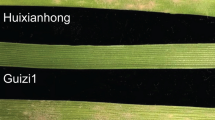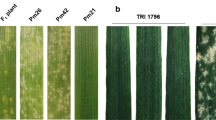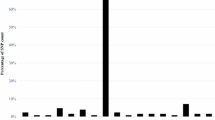Abstract
Wheat powdery mildew, caused by the fungal pathogen Blumeria graminis f. sp. tritici (Bgt), is one of the most devastating diseases of wheat in China and causes serious yield losses. Resistance genes are urgently needed by wheat breeding programs to combat this disease. In the present study, genetic analysis of powdery mildew resistance was conducted on segregated F2 and F2:3 populations derived from the cross of Shangeda (providing good resistance to powdery mildew) and Chancellor (susceptible to powdery mildew). The results showed that the resistance of Shangeda to E09 was controlled by a single recessive gene, tentatively designated as PmSGD. In addition, RNA sequencing of the parental lines Shangeda and Chancellor and the corresponding bulked pools derived from homozygous resistant or susceptible F2:3 lines was implemented to identify single-nucleotide polymorphisms (SNPs). The PmSGD gene was estimated to be located in the 240–250-Mb region of chromosome 7B based on the characteristics of putative SNP loci distributed on 21 wheat chromosomes. Among the developed SNP markers, 17 (57%) markers were linked to PmSGD flanked by SNP2-57 and SNP2-46, with genetic distances of 0.4 and 0.8 cM, respectively. The reaction patterns of Shangeda and cultivars (lines) carrying the Pm5e, Pmhym, mlxbd, and PmTm4 genes to 22 Bgt isolates indicated that PmSGD may be allelic or very closely linked to those genes. All of the SNP loci linked to PmSGD were used to test 38 cultivars with known Pm gene(s), and the results suggested that these SNP loci are useful for pyramiding PmSGD by marker-assisted selection.



Similar content being viewed by others
References
Bennett FGA (1984) Resistance to powdery mildew in wheat: a review of its use in agriculture and breeding programmes. Plant Pathol 33(3):279–300. https://doi.org/10.1111/j.1365-3059.1984.tb01324.x
Cao SQ, Luo HS, Wu CP, Jin SL, Jin MA, Jia QZ, Zhang B, Huang J, Wang XM (2010) Evaluation of 193 Gansu landraces on wheat to powdery mildew. Gansu Agricutural Science and Technology 5:8–10
Chen Z, Wang B, Dong X, Liu H, Ren L, Chen J, Hauck A, Song W, Lai J (2014) An ultra-high density bin-map for rapid QTL mapping for tassel and ear architecture in a large F2 maize population. BMC Genomics 15:1–10
Coram TE, Settles ML, Chen X (2008) Transcriptome analysis of high-temperature adult-plant resistance conditioned by Yr39 during the wheat-Puccinia striiformis f. sp. tritici interaction. Mol Plant Pathol 9(4):479–493. https://doi.org/10.1111/j.1364-3703.2008.00476.x
Fu B, Chen Y, Kong Z, Zhang L, Jia H, Ma Z (2013) pmX: a recessive powdery mildew resistance gene at the Pm4 locus identified in wheat landrace Xiaohongpi. Theor Appl Genet 126(4):913–921. https://doi.org/10.1007/s00122-012-2025-1
Guo Y, Yuan H, Fang D, Song L, Liu Y, Liu Y, Wu L, Yu J, Li Z, Xu X, Zhang H (2014) An improved 2b-RAD approach (I2b-RAD) offering genotyping tested by a rice (Oryza sativa L.) F2 population. BMC Genomics 15(1):956–956. https://doi.org/10.1186/1471-2164-15-956
Hansey CN, Vaillancourt B, Sekhon RS, de Leon N, Kaeppler SM, Buell CR (2012) Maize (Zea mays L.) genome diversity as revealed by RNA-sequencing. PLoS One 7(3):e33071. https://doi.org/10.1371/journal.pone.0033071
Herrera-Foessel SA, Singh RP, Huerta-Espino J, Rosewarne GM, Periyannan SK, Viccars L, Calvo-Salazar V, Lan C, Lagudah ES (2012) Lr68: a new gene conferring slow rusting resistance to leaf rust in wheat. Theor Appl Genet 124(8):1475–1486. https://doi.org/10.1007/s00122-012-1802-1
Hsam SLK, Huang XQ, Zeller FJ (2001) Chromosomal location of genes for resistance to powdery mildew in common wheat (Triticum aestivum L. em Thell.) 6. Alleles at the Pm5 locus. Theor Appl Genet 102(1):127–133. https://doi.org/10.1007/s001220051627
Hu TZ, Li HJ, Xie CJ, You MS, Yang ZM, Sun QX, Liu ZY (2008) Molecular mapping and chromosomal location of powdery mildew resistance gene in wheat variety Tangmai 4. Acta Agron Sin 34:1193–1198
Hu XY, Ohm HW, Dweikat I (1997) Identification of RAPD markers linked to the gene PM1 for resistance to powdery mildew in wheat. Theor Appl Genet 94(6-7):832–840. https://doi.org/10.1007/s001220050484
Huang XQ, Röder MS (2011) High-density genetic and physical bin mapping of wheat chromosome 1D reveals that the powdery mildew resistance gene Pm24 is located in a highly recombinogenic region. Genetica 139(9):1179–1187. https://doi.org/10.1007/s10709-011-9620-y
Huang XQ, Wang LX, Xu MX, Röder M (2003) Microsatellite mapping of the powdery mildew resistance gene Pm5e in common wheat (Triticum aestivum L.) Theor Appl Genet 106(5):858–865. https://doi.org/10.1007/s00122-002-1146-3
Huo ZG, Ye CL, Qian S, Chen L, Liu WC (2002) Relationship between climatic anomaly and prevailling of the wheat powdery mildew in China. Journal of Natural Disasters 11:85–90
Kosambi DD (1943) The estimation of map distances from recombination values. Ann Hum Genet 12:172–175
Lan C, Zhang Y, Herrera-Foesse SA, Basnet BR, Huerta-Espino J, Lagudah ES, Singh RP (2015) Identification and characterization of pleiotropic and co-located resistance loci to leaf rust and stripe rust in bread wheat cultivar Sujata. Theor Appl Genet 128(3):549–561. https://doi.org/10.1007/s00122-015-2454-8
Law CN, Wolfe MS (1966) Location of genetic factors for mildew resistance and ear emergence time on chromosome 7B of wheat. Can J Genet Cytol 8(3):462–470. https://doi.org/10.1139/g66-056
Li Y, Niu YC, Chen XM (2009) Mapping a stripe rust resistance gene YrC591 in wheat variety C591 with SSR and AFLP markers. Theor Appl Genet 118(2):339–346. https://doi.org/10.1007/s00122-008-0903-3
Li ZF, Zheng TC, He ZH, Li GQ, Xu SC, Li XP, Yang GY, Singh RP, Xia XC (2006) Molecular tagging of stripe rust resistance gene YrZH84 in Chinese wheat line Zhou 8425B. Theor Appl Genet 112(6):1098–1103. https://doi.org/10.1007/s00122-006-0211-8
Liu J, Liu D, Tao W, Li W, Wang S, Chen P, Cheng S, Gao D (2000) Molecular marker-facilitated pyramiding of different genes for powdery mildew resistance in wheat. Plant Breed 119(1):21–24. https://doi.org/10.1046/j.1439-0523.2000.00431.x
Liu RH, Meng JL (2003) MapDraw: a Microsoft Excel macro for drawing genetic linkage maps based on given genetic linkage data. Heraditas (Beijing) 25:317–321
Lowry JR, Sammons DJ, Baenziger PS, Moseman JG (1984) Identification and characterization of the gene conditioning powdery mildew resistance in ‘Amigo’ wheat. Crop Sci 24(1):129–132. https://doi.org/10.2135/cropsci1984.0011183X002400010030x
Luo PG, Luo HY, Chang ZJ, Zhang HY, Zhang M, Ren ZL (2009) Characterization and chromosomal location of Pm40 in common wheat: a new gene for resistance to powdery mildew derived from Elytrigia intermedium. Theor Appl Genet 118(6):1059–1064. https://doi.org/10.1007/s00122-009-0962-0
Maccaferri M, Mantovani P, Tuberosa R, Deambrogio E, Giuliani S, Demontis A, Massi A, Sanguineti MC (2008) A major QTL for durable leaf rust resistance widely exploited in durum wheat breeding programs maps on the distal region of chromosome arm 7BL. Theor Appl Genet 117(8):1225–1240. https://doi.org/10.1007/s00122-008-0857-5
Petersen S, Lyerly JH, Worthington ML, Parks WR, Cowger C, Marshall DS, Brown-Guedira G, Murphy JP (2015) Mapping of powdery mildew resistance gene Pm53 introgressed from Aegilops speltoides into soft red winter wheat. Theor Appl Genet 128(2):303–312. https://doi.org/10.1007/s00122-014-2430-8
Qi LL, Chen PD, Liu DJ, Zhou B, Zhang SZ, Sheng BQ, Xiang QJ, Duan XY, Zhou YL (1995) New resistance resource to powdery mildew—gene Pm21. Acta Agron Sin 21:257–262
Ramirez-Gonzalez RH, Segovia V, Bird N, Fenwick P, Holdgate S, Berry S, Jack P, Caccamo M, Uauy C (2015) RNA-Seq bulked segregant analysis enables the identification of high-resolution genetic markers for breeding in hexaploid wheat. Plant Biotechnology J 13(5):613–624. https://doi.org/10.1111/pbi.12281
Ren RS, Wang MN, Chen XM, Zhang ZJ (2012) Characterization and molecular mapping of Yr52 for high-temperature adult-plant resistance to stripe rust in spring wheat germplasm PI183527. Theor Appl Genet 125(5):847–857. https://doi.org/10.1007/s00122-012-1877-8
Ren Y, Li SR, Wei YM, Zhou Q, Du XY, He YJ, Zheng YL (2015) Molecular mapping of a recessive stripe rust resistance gene yrMY37 in Chinese wheat cultivar Mianmai 37. Mol Breeding 35:293–293
Rogers SO, Bendich AJ (1985) Extraction of DNA from milligram amounts of fresh, herbarium and mummified plant tissues. Plant Mol Biol 5(2):69–76. https://doi.org/10.1007/BF00020088
Sheng BQ (1988) Wheat powdery mildew was recorded using infection type in seedling stage. Plant Prot 1:49
Takagi H, Abe A, Yoshida K, Kosugi S, Natsume S, Mitsuoka C, Uemura A, Utsushi H, Tamiru M, Takuno S, Innan H, Cano LM, Kamoun S, Terauchi R (2013) QTL-seq: rapid mapping of quantitative trait loci in rice by whole genome resequencing of DNA from two bulked populations. Plant J 74(1):174–183. https://doi.org/10.1111/tpj.12105
Trapnell C, Williams BA, Pertea G, Mortazavi A, Kwan G, van Baren MJ, Salzberg SL, Wold BJ, Pachter L (2010) Transcript assembly and quantification by RNA-seq reveals unannotated transcripts and isoform switching during cell differentiation. Nat Biotechnol 28(5):511–515. https://doi.org/10.1038/nbt.1621
Trick M, Adamski NM, Mugford SG, Jiang CC, Febrer M, Uauy C (2012) Combining SNP discovery from next-generation sequencing data with bulked segregant analysis (BSA) to fine-map genes in polyploid wheat. BMC Plant Biol 12(1):14. https://doi.org/10.1186/1471-2229-12-14
Wan YX, Zhang XK, Xia XC, Zhang PZ, He ZH (2008) Development of multiplex PCR and identification of major quality genes in cultivars from Yellow and Huai River valley wheat region. Sci Agric Sin 41:643–653
Wang JM, Kang ZS, Liu HY (2009) Genetic analysis and location of a powdery mildew resistance gene in wheat landrace Hongyoumai by SSR marker. Acta Phytopathologica Sinica 39:285–289
Wang XY, Chen PD, Zhang SZ (2001) Pyramiding and marker-assisted selection for powdery mildew resistance genes in common wheat. Acta Genet Sin 28(7):640–646
Wang Z, Li H, Zhang D, Zhang D, Guo L, Chen J, Chen Y, Wu Q, Xie J, Zhang Y, Sun Q, Dvorak J, Luo MC, Liu Z (2015) Genetic and physical mapping of powdery mildew resistance gene MlHLT in Chinese wheat landrace Hulutou. Theor Appl Genet 128(2):365–373. https://doi.org/10.1007/s00122-014-2436-2
Worthington M, Lyerly J, Petersen S, Brown-Guedira G, Marshall D, Cowger C, Parks Ryan MJP (2014) MlUM15: an Aegilops neglecta-derived powdery mildew resistance gene in common wheat. Crop Sci 54(4):1397–1406. https://doi.org/10.2135/cropsci2013.09.0634
Xiao M, Song F, Jiao J, Wang X, Xu H, Li H (2013) Identification of the gene Pm47 on chromosome 7BS conferring resistance to powdery mildew in the Chinese wheat landrace Hongyanglazi. Theor Appl Genet 126(5):1397–1403. https://doi.org/10.1007/s00122-013-2060-6
Xu X, Bai G, Carver BF, Shaner GE, Hunger RM (2005) Molecular characterization of slow leaf-rusting resistance in wheat. Crop Sci 45(2):758–765. https://doi.org/10.2135/cropsci2005.0758
Xue F, Zhai WW, Duan XY, Zhou YL, Ji WQ (2009) Microsatellite mapping of powdery mildew resistance gene in wheat land-race Xiaobaidong. Acta Agron Sin 35:1806–1811
Yuan XP (2009) Identification and evaluation on main agronomic characters and disease resistance of the spring wheat landraces. Journal of Anhui Agricultural Sciences 37:28–30
Zhai WW, Duan XY, Zhou YL, Ma H (2008) Inheritance of resistance to powdery mildew in four Chinese landraces. Plant Prot 34:37–40
Zhang H, Yang Y, Wang C, Liu M, Li H, Fu Y, Wang Y, Nie Y, Liu X, Ji W (2014) Large-scale transcriptome comparison reveals distinct gene activations in wheat responding to stripe rust and powdery mildew. BMC Genomics 15(1):898. https://doi.org/10.1186/1471-2164-15-898
Zhang R, Sun B, Chen J, Cao A, Xing L, Feng Y, Lan C, Chen P (2016) Pm55, a developmental-stage and tissue-specific powdery mildew resistance gene introgressed from Dasypyrum villosum into common wheat. Theor Appl Genet 129(10):1975–1984. https://doi.org/10.1007/s00122-016-2753-8
Zhang Y, Wang L, Xin H, Li D, Ma C, Ding X, Hong W, Zhang X (2013) Construction of a high-density genetic map for sesame based on large scale marker development by specific length amplified fragment (SLAF) sequencing. BMC Plant Biol 13(1):141. https://doi.org/10.1186/1471-2229-13-141
Zhao NJ, Xue F, Wang CY, Han JR, Ji WQ, Zheng L (2010) SSR analysis of powdery mildew resistance gene in Chinese wheat landrace Baihulu. Journal of Triticeae Crops 30:411–414
Zhao X, Xu H, Li X, An D (2012) Genetic analysis of resistance to powdery mildew in three Chinese wheat landraces. Plant Prot 38:51–54
Zhou R, Zhu Z, Kong X, Huo N, Tian Q, Li P, Jin C, Dong Y, Jia J (2005) Development of wheat near-isogenic lines for powdery mildew resistance. Theor Appl Genet 110(4):640–648. https://doi.org/10.1007/s00122-004-1889-0
Zhou XL, Wang MN, Chen XM, Lu Y, Kang ZS, Jing JX (2014) Identification of Yr59 conferring high-temperature adult-plant resistance to stripe rust in wheat germplasm PI 178759. Theor Appl Genet 127(4):935–945. https://doi.org/10.1007/s00122-014-2269-z
Acknowledgements
This work was financially supported by the National Key Research and Development Program of China (2016YFD0300705), the Special Fund for Agro-scientific Research in the Public Interest (201303016). The authors are grateful to Dr. S.C. Xu and T.G. Liu, Chinese Academy of Agricultural Sciences, China, and Dr. X.M. Xu, NIAB East Malling Research, Kent, UK, for the excellent proposal for this research.
Author information
Authors and Affiliations
Corresponding author
Electronic supplementary material
Supplementary Data 1
(XLS 22 kb)
Supplementary Data 2
(XLS 9180 kb)
Supplementary Data 3
(XLS 366 kb)
Supplementary Data 4
(XLS 391 kb)
Supplementary Data 5
(XLSX 13243 kb)
Supplementary Data 6
(XLS 27 kb)
Rights and permissions
About this article
Cite this article
Xu, X., Li, Q., Ma, Z. et al. Molecular mapping of powdery mildew resistance gene PmSGD in Chinese wheat landrace Shangeda using RNA-seq with bulk segregant analysis. Mol Breeding 38, 23 (2018). https://doi.org/10.1007/s11032-018-0783-4
Received:
Accepted:
Published:
DOI: https://doi.org/10.1007/s11032-018-0783-4




